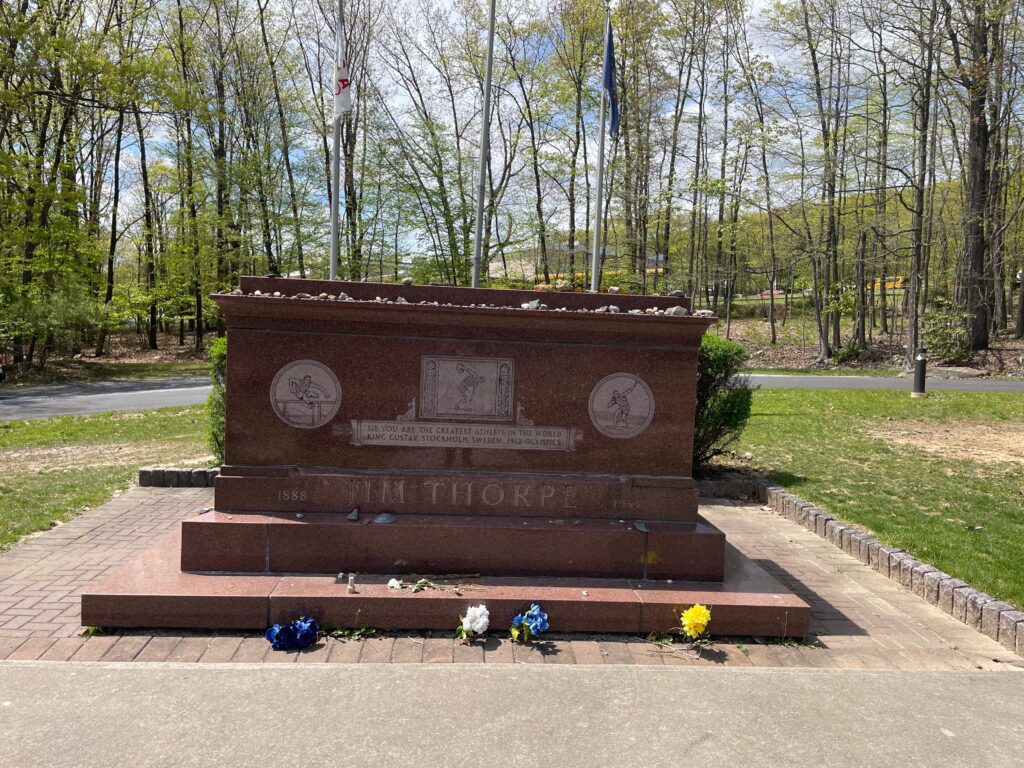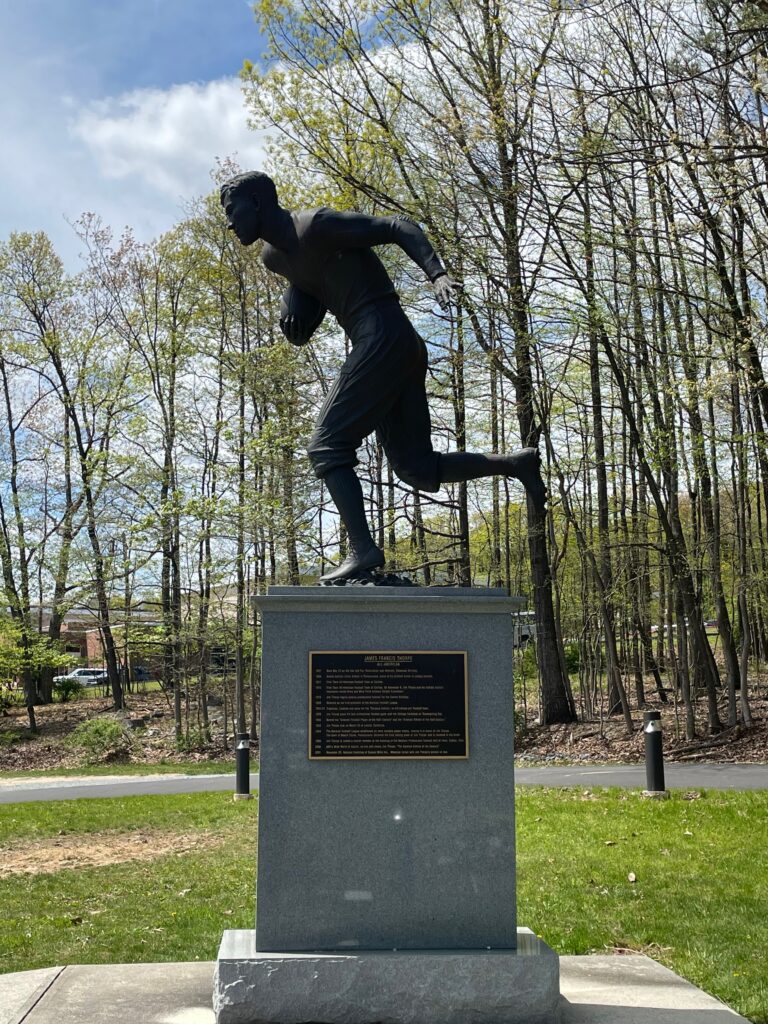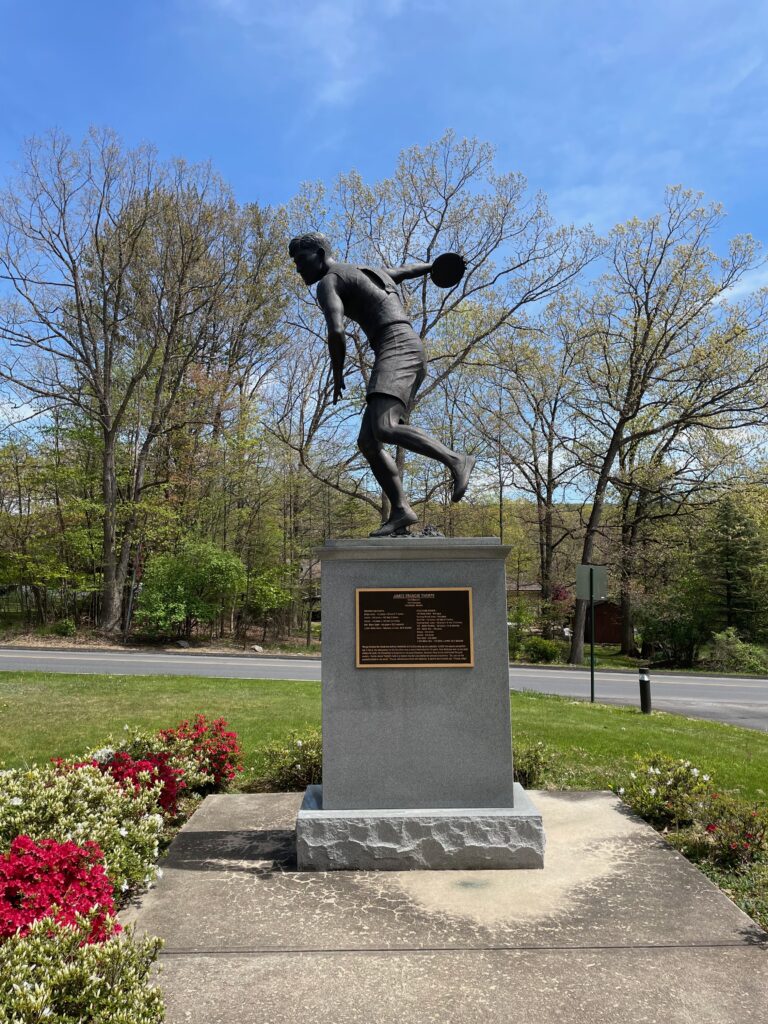Erik Visits an American Grave, Part 1,604
This is the grave of Jim Thorpe.



Born in 1887 near Prague, Oklahoma, Thorpe grew up on the Sac and Fox Nation on what was once Indian Territory (basically the idea was a gigantic ghetto to throw the Indians and hopefully forget about them) and then Oklahoma when whites decided they wanted that land too. As a kid, like so many Native kids, he was stolen by the federal government and forced into the Indian Schools, in this case the infamous one at Carlisle, Pennsylvania. Here, he like others, was forced to cut his hair, were beaten or starved if they spoke their own language, coerced into accepting Christianity (though in this particular case, Thorpe’s parents were already Catholic and thus so was he). Kill the Indian and save the man, said Carlisle head Richard Henry Pratt.
This would be traumatic for anyone, or at least anyone who survived since many did not. He initially went to the Haskell Indian School in Kansas, but kept running away. so off to Carlisle for him! He was in and out of school for quite awhile. In 1907, he found a path forward–sports. Thorpe was of course a phenomenal athlete, one of the greatest in the history of this country. He walked out onto the track in his street clothes and out-jumped everyone else at the school in the high jump. This got the attention of the track coach, a certain fellow named Pop Warner. Thorpe was already competing in track, basketball, and ballroom dancing. In fact, he would win the 1912 national college title in ballroom dancing! Warner was putting together his great football teams, launching his own career as one of the great early coaches, but he wasn’t sure he wanted Thorpe, not because of his ability but because the physicality of football might impact the other sports, which Warner also coached. Thorpe convinced him to give him a shot and he was so good that Warner caved.
Thorpe became the greatest player college football had seen to this time. He played running back, defensive back, and did the kicking. Carlisle won the 1912 national championship thanks to Thorpe and Warner, including kicking Army’s ass, an Army team with Dwight Eisenhower on it for that matter. He loved football more than anything else and stopped competing in track for awhile, but then decided to train for the 1912 Olympics. He competed in the pentathlon and decathlon, which are still really the most athletically astounding events. It’s one thing to be competitive in one event, but in like 10???? He had never even competed in a decathlon before! So naturally he won the gold in both!!!
Thorpe became a huge star in the United States. This was the precise moment in which Americans were already romanticizing the West, developing its sports culture, and creating celebrity culture. Thorpe hit the Venn diagram for all of these. So he got a ticker-tape parade on Broadway. But the ridiculous culture of amateurism came back to haunt Thorpe. Needing money and just liking to compete, in 1913, it came out of that Thorpe had played some low-level pro baseball. NOT THAT! He had received a couple of bucks a game in 1909 and 1910 to play for a team in North Carolina. This was super common, but most college players used an alias when doing so. Thorpe didn’t take that precaution. He admitted it and tried to get around it by playing the Dumb Indian. Like, literally. His letter stating his case read, in part,
I hope I will be partly excused by the fact that I was simply an Indian schoolboy and did not know all about such things. In fact, I did not know that I was doing wrong, because I was doing what I knew several other college men had done, except that they did not use their own names …
Good try, but it didn’t work. Now, the Olympics had a rule about amateurism that any claims had to be made within 30 days of the end of the games. It waived its own rule to strip Thorpe of all his medals.
So Thorpe ended up in professional sports. He signed with the New York Giants in baseball and played a few games here and there, but the only time he played more than 100 games was in 1917, most of them after being traded to the Cincinnati Reds. He never hit much and over 698 at bats between 1913 and 1919, he hit .252/286/362. He played some professional football too. In 1915, he signed with the Canton Bulldogs, which became an original founder of the National Football League in 1920. He then created his own all-Native NFL team, the Oorang Indians out of LaRue, Ohio, which was a franchise in 1922 and 1923. They weren’t very good, but did win a few games and Thorpe was named to the NFL All-Pro Team in 1923. He retired from the NFL in 1928, now 41 years old. He also played a little bit of hoops and even dabbled in hockey.
But Thorpe was really not ready for sports to end. It was his only income and he spent too much and his Carlisle education, to say the least, had not provided any actual skills. Like so many graduates of these schools, he faded into poverty, alcoholism, and early death in a society that rejected them. He ended up out in Hollywood, get jobs playing silly Indians in westerns, once playing himself teaching kids to kick in some comedy. He would occasionally work in the movies through the 50s and lived to see his own biopic, where he was played by Burt Lancaster in redface (though at Lancaster could look good as an athlete). But none of this made him much money. He worked as a bouncer, joined the Merchant Marine for a hot minute in 1945, dug ditches, and drank. He was diagnosed with lip cancer in 1950 and survived it, but was a charity case for the hospital. His heart was going too and he died in 1953 of his third attack, out in his California home. He was 65 years old.
Jim Thorpe is buried at the Jim Thorpe Memorial, Jim Thorpe, Pennsylvania.
Wait, what?
Yep, the racism Thorpe faced throughout his life continued in his death. The 1950s was a silly time in some ways. Cities would rename themselves for publicity sake. The town of Hot Springs, New Mexico renamed itself Truth or Consequences as a game show stunt. At least that was harmless, if dumb. This was different. The town of Mauch Chunk, Pennsylvania, a place Thorpe had never been, sent a message to his widow and offered her a bunch of cash for the body. Desperate for money, she agreed. They built this ridiculous monument to him and then renamed their town for him, as a publicity stunt to increase tourism.
This remains quite controversial today. Thorpe’s descendants have sued to get the remains back. But in 2013, in one of the most twisted interpretations of American law I have heard in a long time, Judge Richard Caputo, a Clinton appointee for that matter, ruled that to move his body back to Oklahoma to be with his family would be a violation of the Native American Graves Protection and Repatriation Act. That is like the opposite of what NAGPRA is supposed to here. That was overturned by the 3rd Circuit, but that didn’t solve the body issue and he remains in Pennsylvania today after the Supreme Court refused to hear the case in 2015.
If you would like this series to visit other Native American athletes, you can donate to cover the required expenses here. Chief Bender is in Roslyn, Pennsylvania and Moses Yellowhorse is in Pawnee, Oklahoma. Previous posts in this series are archived here and here.


